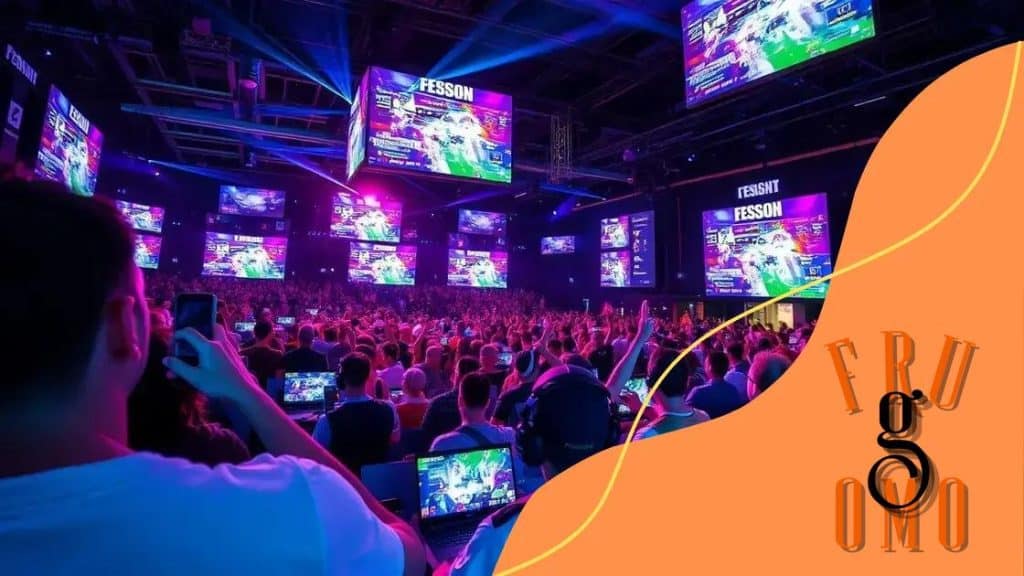How e-sports are influencing mainstream media content

E-sports are significantly influencing mainstream media by integrating tournaments into traditional broadcasts, enhancing audience engagement through interactive content, and enabling brands to connect with diverse, tech-savvy viewers.
How e-sports are influencing mainstream media content is a fascinating phenomenon altering how we consume entertainment today. Have you ever wondered how gaming has become a pivotal part of media conversations? Let’s explore this together!
The rise of e-sports in popular culture
The rise of e-sports in popular culture has been nothing short of remarkable. What was once seen as a niche interest is now a mainstream phenomenon, capturing the attention of millions worldwide. Today, e-sports events fill arenas, attract massive online audiences, and generate significant revenue through sponsorships and advertising.
The cultural significance of e-sports
E-sports now play a vital role in shaping contemporary culture. They bridge gaps between generations and foster communities around shared interests. Gamers of all ages come together to watch tournaments, engage with players on social media, and even compete themselves. This sense of community is one of the factors fueling the popularity of e-sports.
Key factors contributing to the rise
- The accessibility of streaming platforms like Twitch and YouTube
- High engagement levels on social media among gaming fans
- Partnerships with traditional media and major brands
- Rise of mobile gaming that expands the e-sports audience
As e-sports continue to grow, more mainstream media outlets are providing coverage. This has allowed for greater visibility and validation of gaming as a legitimate form of entertainment. While traditional sports have shaped society for decades, e-sports are now influencing how we view entertainment and competition.
Not only are e-sports changing how we entertain ourselves, but they are also affecting how we market products. Brands are eager to engage with the e-sports audience, which is often younger and more diverse than traditional sports fans. By partnering with popular gamers and teams, companies can connect with potential customers in meaningful ways.
Future prospects
Looking ahead, the rise of e-sports seems poised to continue. As technology advances, we can expect even more immersive experiences for fans and players alike. Events will become more elaborate, and the blend of gaming with virtual and augmented reality could redefine engagement.
The continuing rise of e-sports in culture demonstrates a shift in entertainment preferences. It reflects a broader trend where interactive experiences gain priority. Understanding this evolution can provide insights into the future of entertainment, advertising, and community-building in our increasingly digital lives.
E-sports and its impact on traditional media
E-sports have significantly impacted traditional media, altering how fans engage with content. This shift reflects a broader change in entertainment consumption where digital platforms are at the forefront. As e-sports gain popularity, traditional media outlets are adapting to this new landscape.
Changes in viewership
More people are choosing to watch e-sports over traditional sports. This trend leads to a decline in viewership for conventional broadcasting networks. Many younger viewers prefer streaming platforms like Twitch and YouTube, where they can watch their favorite gamers in real-time.
Collaborations between e-sports and media
- Traditional networks are starting to broadcast e-sports tournaments.
- Media companies are creating dedicated channels for e-sports content.
- Partnerships with game developers and brands enhance media coverage.
- Growing interest from advertisers looking to tap into gaming demographics.
As e-sports continue to influence traditional media, traditional outlets are recognizing the need to reinvent their strategies. This can involve investing in original gaming content or hosting live events to attract e-sports fans. Moreover, the popularity of e-sports creates opportunities for innovative storytelling that resonates with audiences.
Brands are also taking note of the synergy between e-sports and media. When companies collaborate with e-sports teams or streamers, they reach a vibrant and engaged community. This is an effective way to promote products and services tailored to a younger audience interested in gaming.
The future of media and e-sports
Looking ahead, the relationship between e-sports and traditional media is likely to strengthen. As technological advancements come, we may see more immersive viewing experiences. Virtual reality or augmented reality could change how audiences interact with e-sports content, making it even more exciting.
The influence of e-sports on traditional media is just beginning. Both mediums are learning from each other and growing alongside this digital revolution. As fans continue to embrace this new era, we can expect to see even more integration between e-sports and traditional media platforms.
How brands are leveraging e-sports

Brands are increasingly recognizing the potential of e-sports and are finding innovative ways to leverage this booming industry. With millions of fans tuning in to watch competitions, companies see a golden opportunity to engage with a younger audience. By associating themselves with gaming, brands can create stronger connections with consumers.
Strategies for brand engagement
Many brands are adopting various strategies to integrate themselves into the e-sports scene. They sponsor teams and tournaments to enhance visibility and trust among gamers. This approach helps build a community around their products, making fans feel like part of something special.
Examples of successful partnerships
- Many beverage companies sponsor large gaming tournaments, providing their products in the venues.
- Tech companies launch products specifically designed for gamers, often in partnership with e-sports teams.
- Fashion brands create limited edition merchandise linked to popular games or teams.
- Automotive brands engage fans through interactive gaming experiences at events.
By collaborating with popular streamers, brands can reach diverse audiences through engaging content. These influencers help create authentic connections, as fans trust their recommendations. When a gaming personality promotes a product, it feels more like a personal suggestion than traditional advertising.
The growth of social media is also essential for brands looking to make their mark in e-sports. Platforms like Twitch and Twitter allow for real-time interactions with fans. Brands can share highlights, special promotions, or content that resonates with the gaming community instantly. This approach enhances brand loyalty as consumers see them actively participating in the events they love.
Future of brand involvement in e-sports
The future of brands in e-sports looks bright as the audience continues to expand. As e-sports events grow in size and popularity, brands will need to explore more creative engagement methods. This could mean creating immersive experiences, such as virtual reality events or interactive content that draws fans in even further.
In a rapidly changing market, brands that adapt to the e-sports culture and customer preferences will thrive. Leveraging platforms, engaging with fans, and building lasting connections are crucial strategies for success as e-sports evolve.
The audience dynamics of e-sports viewership
The audience dynamics of e-sports viewership are fascinating and complex. Millions of fans around the world tune in to watch their favorite teams and players compete, creating a vibrant and engaged community. Understanding these dynamics helps to grasp how e-sports are reshaping the entertainment landscape.
Who watches e-sports?
The demographic of e-sports viewers is diverse, with a strong representation of the younger generation. Many viewers are in the age range of 18 to 34, making them a desirable audience for brands looking to connect with young consumers. This age group often overlaps with gaming culture, creating an environment rich for engagement.
Viewership behaviors
- Many e-sports fans prefer streaming platforms over traditional TV.
- Social media plays a significant role in how fans interact during events.
- Fans often engage with content by chatting, sharing, and reacting in real-time.
- Participating in online communities enhances their viewing experience.
One of the significant habits among e-sports viewers is the tendency to engage deeply with content. Many fans watch not just for the competition but also for the personalities involved. Streamers and players have developed large followings, often fostering a sense of connection with their audiences. As a result, fans feel more included in the gaming experience, which keeps them coming back for more.
Additionally, e-sports events often incorporate interactive elements that enhance viewer engagement. For example, viewers may vote on game outcomes or participate in fantasy leagues related to their favorite teams. This level of participation transforms passive viewers into active participants, enriching the overall experience and sense of community.
The influence of technology on viewership
Technological advancements have shaped how e-sports are consumed. With high-speed internet and mobile access, fans can watch matches anytime, anywhere. This flexibility allows e-sports to reach a global audience, breaking down barriers associated with traditional media.
As e-sports evolve, the audience dynamics will likely continue to shift. Understanding who these viewers are and how they engage is crucial for brands looking to connect with this growing audience. By tailoring content and marketing strategies to fit the unique preferences of e-sports fans, companies can build lasting relationships and capitalize on this booming industry.
Future trends: e-sports and mainstream media
The future trends of e-sports and their intersection with mainstream media are shaping up to be exciting and transformative. As both industries evolve, there are several key developments that are likely to influence how we consume entertainment in the coming years.
Increased integration of e-sports in traditional media
We are already seeing a shift where mainstream media outlets are beginning to invest heavily in e-sports content. News channels are covering major league tournaments, and documentaries about renowned players are becoming more common. This integration allows e-sports to reach broader audiences who may not have previously engaged with gaming.
Growth of interactive content
- Viewers may participate in live polls during matches.
- Games will feature interactive elements that influence gameplay based on audience votes.
- Innovative experiences such as augmented reality will enhance viewing.
- Platforms will provide customized content based on user preferences.
As technology advances, the viewing experience will become more immersive. Fans might use augmented reality applications to feel as if they are part of the action. Such innovations will likely draw in fans from both gaming and traditional sports worlds.
Emerging platforms and streaming services
Streaming services are rapidly evolving, and many are dedicated solely to e-sports. These platforms offer competitions, player interviews, and game tutorials, catering specifically to gaming enthusiasts. This shift away from traditional cable offers room for growth and experimentation in how content is produced and delivered.
As more viewers turn to on-demand programming, traditional networks will need to adapt. They may need to explore new business models and marketing strategies to capture the attention of e-sports fans. This could mean offering exclusive content or interactive viewing experiences that attract a younger demographic.
Opportunities for brands and advertisers
Brands are recognizing the massive audience e-sports attract and are keen to get involved. The future will likely see more collaborations between e-sports teams and big-name brands. Advertisements may also become more tailored to individuals based on viewing habits, creating a personalized touch.
Overall, the trends of e-sports and mainstream media are proving to be interconnected as they evolve together. With numerous possibilities for cross-promotion and engagement, the future promises to broaden how audiences enjoy both e-sports and traditional entertainment.
The future of e-sports and mainstream media is bright and full of opportunities. As both industries continue to evolve together, they create exciting possibilities for audiences, brands, and content creators alike. By understanding audience dynamics, leveraging technology, and adapting marketing strategies, companies can thrive in this shifting landscape. E-sports not only provide entertainment but also forge communities and connections that transform how we engage with media. Looking ahead, it’s clear that the integration of e-sports into mainstream culture will only grow, leading us to an exciting era of innovation.
\n\n\n
\n
\n
FAQ – Frequently Asked Questions about E-sports and Mainstream Media
How are e-sports changing traditional media?
E-sports are increasingly being integrated into traditional media, with news outlets covering major tournaments and creating documentaries about players.
What interactive elements can viewers expect in e-sports?
Viewers may participate in live polls, vote on game outcomes, and enjoy augmented reality features that enhance their viewing experience.
Which platforms are gaining popularity for e-sports streaming?
Dedicated streaming services for e-sports are rising, giving fans access to competitions, player interviews, and engaging content.
How can brands effectively engage with e-sports audiences?
Brands can connect with e-sports fans by sponsoring teams, collaborating with popular streamers, and creating tailored marketing strategies.





